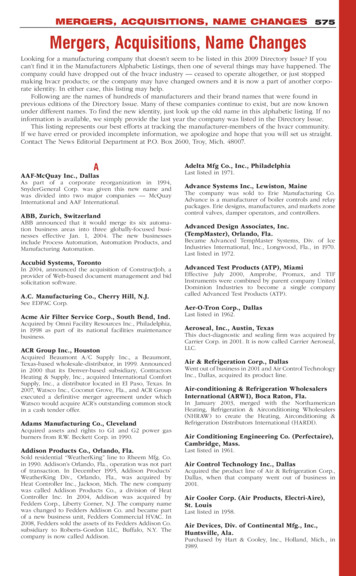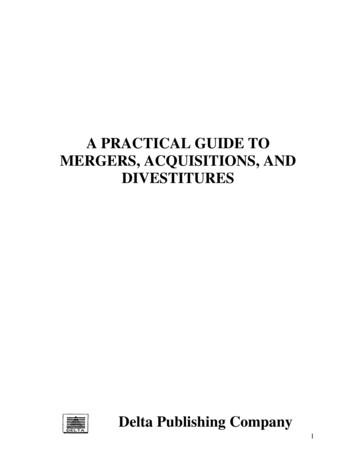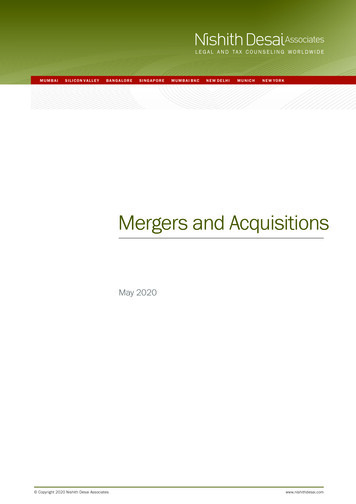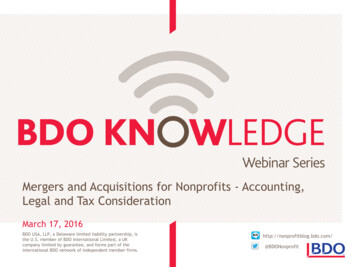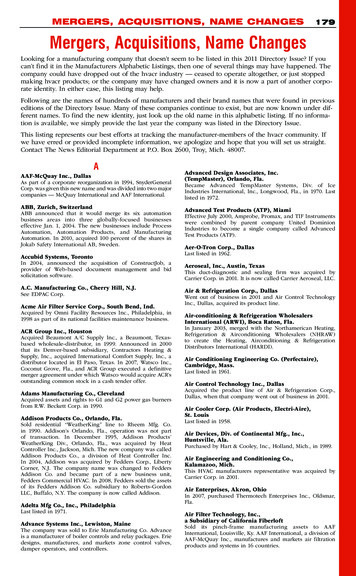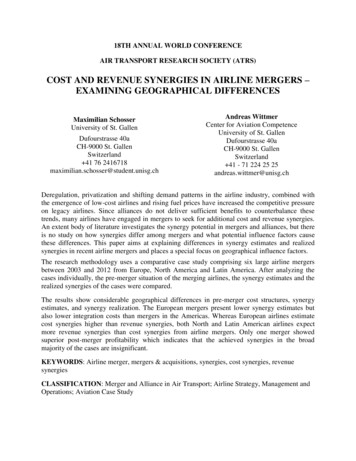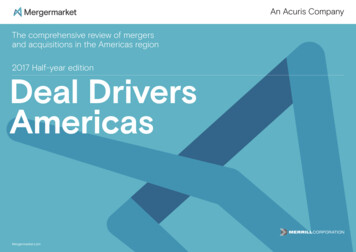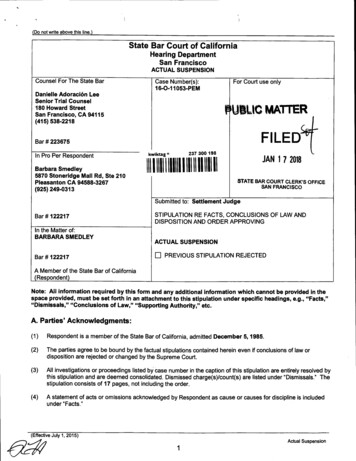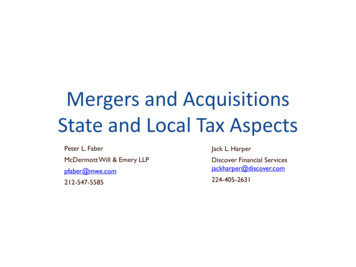
Transcription
Mergers and AcquisitionsState and Local Tax AspectsPeter L. FaberJack L. HarperMcDermott Will & Emery LLPpfaber@mwe.comDiscover Financial -2631
PRELIMINARY CONSIDERATIONS1. Get SALT people involved at the outset.2. The application of state tax laws to corporatetransactions is often unclear. Many states do not have the equivalent of the JointCommittee on Taxation staff.3. Corporations that file consolidated federalincome tax returns often file separate returnsin one or more states or file on a combinedbasis with different group members. This can result in dramatic differences between thefederal and state taxation of transactions. It can also mean that the target has joint andseveral liability for taxes of other entities that arenot involved in the transaction.2
INCOME TAX ISSUES Nexus Issues Business v. nonbusiness income.– Asset acquisitions.– Stock acquisitions. 338(h)(10) transactions. Acquisitive reorganizations under section368. Spin-offs and restructurings. Net operating loss carryovers in acquisitions. Ongoing planning.3
INCOME TAX NEXUS BYACQUISITION TARGET Acquiring target’s assets located in ajurisdiction where acquirer is not taxable willoften cause acquirer to become taxable in thatjurisdiction. Acquiring target’s stock may result in acquirerand target having to file state combined returnsif engaged in a unitary business.– A unitary relationship may not be establishedimmediately unless the corporations have a priorbusiness relationship. Effect of acquisition on acquirer’s incomeapportionment factors. Economic or attributional nexus.4
BUSINESS v. NONBUSINESSINCOMESIGNIFICANCE: Most states tax business income differently thannonbusiness income. Business income is typically apportioned among allthe states in which a company does business under aformula (often based on a combination of thelocation of property, payroll, and sales, although useof sales-only formulas is increasing). Nonbusiness income is typically allocated to onestate only.– The state of physical location, in case of tangibleproperty.– The state of commercial domicile in case of good willand other intangible property. Corporations usually prefer gain on the sale of abusiness to be nonbusiness income, but this is notalways the case.5
BUSINESS v. NONBUSINESSINCOME: ASSET SALES UNIFORM DIVISION OF INCOME FOR TAXPURPOSES ACT (“UDITPA”):– Business income is: “Income arising fromtransactions and activity in the regular course ofthe taxpayer’s trade or business and includesincome from tangible and intangible property ifthe acquisition, management, and disposition ofthe property constitute integral parts of thetaxpayer’s regular trade or business operations.”Section 1(a).6
BUSINESS v. NONBUSINESSINCOME: ASSET SALESTwo tests for business income have been developedby the courtsAll courts agree that gain on the sale of property (e.g.,inventory) that is sold in the regular course of businessproduces business income, even if sold in bulk in anextraordinary transaction (the “transactional test”).– The courts have divided on whether gain on the sale ofproperty that is used to produce business income (e.g.,a factory) is business income (the “functional test”).– Cases holding that there is a functional test includeGannett Satellite Information Network Inc. v. MontanaDep’t of Rev., 348 Mont. 333 (2009); Welded Tube Co.v. Commonwealth, 101 Pa. Commw. 32, 515 A.2d 988(1986).– Cases holding that there is no functional test includeWestern National Gas Co. v. McDonald, 202 Kan. 98,446 P.2d 781 (1968); McVean & Barlow, Inc. v. N.M. Bur.Of Rev., 88 N.M. 521, 543 P.2d 489 (1975).7
BUSINESS v. NONBUSINESSINCOME: ASSET SALESShould there be a functional test?YES: Tax Policy. The value of an asset that is used in thebusiness is attributable to its ability to produce futurebusiness income and gain on its sale should bebusiness income.NO: Statutory Language. The statute says “and,” not“or.” Gain on the sale of an asset is nonbusinessincome unless the disposition of the asset is a regularincident of the taxpayer's business.8
BUSINESS v. NONBUSINESSINCOME: ASSET SALESLIQUIDATING SALES– Some courts that follow the functional test have held that gain on the saleof business assets that would ordinarily be business income is nonbusinessincome if the sale proceeds are distributed to the shareholders and notreinvested in the seller’s business. See, e.g., Laurel Pipe Line Co. v.Comm’w of Pa., 537 Pa. 205,642 A. 2d 472 (1994); Lenox, Inc. v. Tolson, 353N.C. 659, 548 S.E.2d 513 (2001).– The same principle may be applied to a corporation that is deemed to havesold its assets and liquidated under section 338(h)(10) of the InternalRevenue Code. See, e.g., Canteen Corp. v. Comm’w of Pa., 818 A.2d 594(2003), aff’d, 854 A.2d 440 (Pa. Sup. Ct. 2004); ABB C-E Nuclear Power Inc.v. Mo. Dir. of Rev., 215 S.W.3d 85 (Mo. 2007).9
BUSINESS v. NONBUSINESSINCOME: ASSET SALESLIQUIDATING SALES– What is a liquidation? A distribution of the sale proceeds to the shareholders? The sale of a business? See Glatfelter Pulpwood Co. v.Comm’n of Pa, 19 A.3d 572 (Pa. Comm. Ct. 2011). No liquidation when sale was of only some of the assets ofa worldwide business and sale proceeds were notdistributed to shareholder. Elan Pharmaceuticals, Inc. v.Director, Div. of Tax. (N.J. Tax Ct. 2014)– Reinvestment of proceeds in a unitary business mayprevent a “liquidation” for this purpose. Century Tel,Inc. v. Dep’t of Revenue (Ore. Tax Ct. 2010).10
LIQUIDATING SALES Some courts have held that there is noliquidation exception to the functional test. JimBeam Brands Co. v. Franchise Tax Bd., 34 Cal.3d874 (2005); Crystal Communications, Inc. v.Oregon Dep’t of Revenue, 353 Ore. 300, 297P.3d 1256 (2013); First Data Corp. v. ArizonaDepartment of Revenue, 233 Ariz. 405, 313 P.3d548 (AZ. Ct. App. 2013); Harris Corp. v. ArizonaDepartment of Revenue, 233 Ariz. 377, 313 P.3d1143 (AZ. Ct. App. 2013).11
BUSINESS v. NONBUSINESSINCOME: ASSET SALESCONCLUSIONS. The law is unclear as to whether there is afunctional test. Taxpayers should nothesitate to dispute department of revenuedeterminations. Taxpayers can take inconsistent positions indifferent states. Oracle Corp. v. Ore. Dep’tof Rev. (Ore. Tax Ct. 2010).12
BUSINESS v. NONBUSINESSINCOME: STOCK SALES Gains from the sale of a subsidiary’s stock willgenerally be business income only if the parentand the subsidiary were engaged in a unitarybusiness. Allied-Signal, Inc. v. Director, Div. ofTaxation, 504 U.S. 768 (1992). The mere intent to create a unitaryrelationship does not convert a subsidiary’sstock to a business asset if it is sold before therelationship is created. Calif. F.T.B. Legal RulingNo. 2012-01.13
338(h)(10) TRANSACTIONS Under section 338(h)(10) of the InternalRevenue Code, a sale of the stock of acorporate subsidiary or an S corporation istreated as if the corporation had sold its assetsand distributed the sale proceeds to itsshareholders in liquidation. The actual sale ofstock is ignored. The incident of tax is the deemed sale of thecorporation’s assets by the target corporation. The buyer and the seller must elect to havesection 338(h)(10) apply. The provision’s purpose is to allow the buyer ofa corporation’s stock to step up the basis of thecorporation’s assets to reflect the purchaseprice, as it would if it bought the assets directly.14
338(h)(10) TRANSACTIONS The states generally follow section 338(h)(10) inthat they allow the basis step-up of the targetcorporation’s assets and otherwise respect thefiction of the deemed sale and liquidation. Whether 338(h)(10) treatment is available canaffect pricing. California and Wisconsin allow taxpayers to electinto or out of section 338(h)(10) regardless ofwhether they elect it for federal tax purposes. Treatment of deemed sale proceeds in receiptsfactor can be an important issue.15
338(h)(10) TRANSACTIONSTRAP: In the typical 338(h)(10) transaction, the selling parent and thetarget file consolidated federal income tax returns and thetarget’s gain on the deemed sale of its assets is taxed on theparent’s return that includes the target. If the parent and the target file separate state returns, there isno mechanism for including the target’s gain on the deemedsale of its assets on a parent tax return. The tax on the gain is aliability of the target and the economic burden of the tax will beborne by the buyer. Newell Window Furnishing, Inc. v. Comm’rof Rev., 311 S.W.3d 441 (Tenn. Ct. App. 2008). Solution: Reduce the purchase price to transfer the economicburden of the tax to the seller.16
338(h)(10) TRANSACTIONS NYS Tax Reform Legislation: need to identifystock on the day of purchase as being held forinvestment for income from that stock to betax-free investment income. Is the target treated as a new corporation forthis purpose so that it must make a newidentification on the closing date, even thoughit may have made a prior identification?17
TAX-FREE REORGANIZATIONS State income taxes generally conform tothe federal reorganization provisions anda transaction that is a tax-freereorganization under IRC section 368 willbe tax-free for state income tax purposes. WARNING: a transaction that is notsubject to federal, state, and local incometaxes may be subject to state and localgross receipts, sales, and real propertytransfer taxes.18
NYS INVESTMENT INCOMEIDENTIFICATION NYS Tax Reform Legislation: need to identifystock on the day of purchase as being held forinvestment for income from that stock to betax-free investment income. The acquiring corporation in a merger shouldmake a new identification on the closing date.There is no authority suggesting that anidentification made by the mergedcorporation carries over.19
SPIN-OFFS AND RESTRUCTURINGS The distribution of the stock of a subsidiarycorporation will generally be tax-free to thedistributing parent and the parent’sshareholders if the corporations are eachengaged in an active business, there is a nontax business purpose for the distribution,and the distribution is not a device todistribute the parent’s earnings and profits.IRC section 355. The states generally follow the federaltreatment of spin-offs. A spin-off thatqualifies under section 355 will generally betax-free for state income tax purposes.20
SPIN-OFFS AND RESTRUCTURINGSAREAS OF NONCONFORMITY WITH FEDERALRULES New Hampshire does not follow the federal rulethat qualification under the active business testis determined on an affiliated group (and not aseparate corporation) basis because it conformsto the Internal Revenue Code as in effect beforethe effective date of IRC section 355(b)(3). California statute conformed to section355(b)(3) as of January 1, 2010, but, becausethe bill of which it was a part was not adoptedby the 2/3 vote required for tax increases, it mayhave been invalid. It is understood that the FTBwas applying it as if it were in force. This hasapparently been corrected by legislationenacted in 2015.21
SPIN-OFFS AND RESTRUCTURINGS Internal restructurings typically involve assettransfers that can have tax consequences. The distribution of assets from a subsidiarycorporation to a corporate shareholder canresult in the recognition of gain to the subsidiaryunder I.R.C. section 311(b).– The gain may be deferred for federal tax purposes ifthe corporations are filing consolidated returns, butit will be taxed immediately for state tax purposes instates in which the corporations are filing separatestate returns. Transfers within a corporate group may result insales or other transfer taxes.22
NET OPERATING LOSSCARRYOVERS The states often have special rules for netoperating loss carryovers (NOLs) that donot track the federal rules. Taxpayers should not assume that NOLsthat are available for federal tax purposeswill be available for state tax purposes.23
NET OPERATING LOSSCARRYOVERS States often have shorter carryforward periods than thefederal 20-year period.– NOLs that are still available for federal tax purposes mayhave expired in one or more states.– NOLs may be suspended, sometimes for state budgetaryreasons. Some states allow NOLs only to the extent that they areattributable to in-state activities. Use of NOLs may vary if state combined group is differentfrom federal consolidated group. Apportionment of NOLs may vary, affecting availability ofNOLs in different states.24
NET OPERATING LOSSCARRYOVERS Some states do not have a provision allowing NOLs or unused credits tomove from the target corporation to the buyer in a tax-freereorganization comparable to IRC section 381. In those states, the NOLs may be extinguished in the transaction. SeeA.H. Robins Co., Inc. v. Director, 182 N.J. 77 (2004). Case law in some states has held that the target’s NOLs neverthelesssurvive the transaction if the buyer after the transaction continues thetarget’s business that generated the NOLs, See, e.g., Oliver’s Laundry &Dry Cleaning Co. v. Ariz. State Tax Comm., 19 Ariz. App. 442, 508 P2d107 (1973); Thermatool Corp. v. Dep’t of Rev. Services, 43 Conn. Sup260, 651 A2d 763 (1994). WARNING: This is a potential problem when a corporation with NOLs isreincorporated in another state by merging into a new “shell”corporation.25
NET OPERATING LOSSCARRYOVERS Idaho statute: NOL passes in a merger but notin a “C” reorganization or in a section 332liquidation. Idaho Decision 25749 (2014) incorrectly holdsthat a wholly-owned subsidiary’s NOLs do notpass to its parent when it merges into theparent, citing IRC section 382. TheCommission’s mistakes: (1) section 382 doesnot apply to a merger of a subsidiary into aparent, and (2) section 382 limits the use ofthe NOL but does not prevent it from passingto the parent.26
SALES TAX ISSUES “Sale” is broadly defined to include all transfers oftitle or possession of goods for consideration“unless otherwise excepted”. Consideration isconsidered both cash and the assumption ofliabilities. Exceptions –Sales of businesses must bespecifically exempted in order to escape the salestax.– Not a transaction occurring in the ordinary course ofbusiness - Isolated, Casual or Occasional sales.– Reorganization Exemption specifically provided bystatute.27
SALES TAX ISSUES Sales Tax Exemptions for Transfers inIncorporations, Mergers, Acquisitions, &Liquidations– Strict compliance with statutory language and/orregulations is mandatory or the exemption will beforfeited.– State sales tax analysis must be done beforestructuring the transaction based solely on federalincome tax consequences, or significant salestaxes could be due.28
Sales Tax Problem Areas Creation of new subsidiaries and drop downassets with parent receiving consideration inthe form of stock and securities in thesubsidiaries. Tennessee held a taxable saleoccurred. In D. Canalle & Co. (Tenn. Jan. 17,1989). Some states exempt transfers in exchangefor an equity interest that occurs “at thetime of organization of the entity”. NewYork, New Jersey and Vermont. Later transfers may be taxable. Noar Trucking C. Inc., v. State TaxCommission 138 A.D. 2d 869 (3d Dept. 1988).29
Sales Tax Problem Areas Section 351 incorporation transactions maybe subject to sales taxes, although manystates have partial exemptions.– Liabilities that are assumed or taken subject to may be treated as cash thatis not eligible for exemption. Beatrice Co. v. SBE, 6 Cal. 4th 767, 863 P.2d683 (1993).– New York’s exemption applies only to transfers upon the organization ofthe transferee corporation. The economically meaningless issuance of new stockto a 100% shareholder can result in sales tax eventhough a capital contribution of unencumbered assetsfor no new stock would be exempt. Petition ofWeichbrodt, N.Y.S. Tax App. Trib. (2002). A transfer to a dormant “shell” corporation is taxable.P-H Fine Arts Ltd. v. N.Y.S. Tax App. Trib., 227 App. Div.2d 683 (3d Dep’t 1996); Petition of Mohonk Oil Co.,Inc., Tax App. Trib. (2009).30
Sales Tax Problem AreasSMLLC Transfer assets to SMLLC followed by the sale of the SMLLC interest.– New York– no sales tax due.– Washington State and California – sales tax willbe due.Sec. 338(h)(10) Application of Sec. 338(h)(10) to Sales Tax. Generally, for sales taxpurposes the deemed asset sale is not treated as an actual sale, and thesales tax normally would not apply.31
BULK SALES/SUCCESSOR LIABILITYISSUES In order to protect their tax revenues, most stateshave one or more bulk sale or successor liabilityprovisions in their tax laws.– These provisions generally require the seller and/orpurchaser of the assets of a business to notify theappropriate taxing authorities of the sale within acertain number of days before the transaction.– The purpose of the request is to either:1. obtain a clearance certificate from the authoritiesstating that the seller has no outstanding taxliabilities; or2. be instructed by the authorities as to the amountthat should be withheld by the purchaser from thepurchase price to cover the outstanding tax liabilitiesof the seller.32
DUE DILIGENCE Develop check-list of SALT issues. Vary the check-list for industry-specific andcompany-specific issues. Watch out for aggressive tax planningstrategies. Focus on key states if time and budget do notallow you to survey all states.774284861V1 1.ppt33
Other State Tax Issues Sec. 409A State Income Tax Withholding Employee v. Independent ContractorClassifications State Unemployment Taxes– “Successor Employer”– Experience Rating Transfers78543290 1.ppt34
TAX-FREE REORGANIZATIONS State income taxes generally conform to the federal reorganization provisions and a transaction that is a tax-free reorganization under IRC section 368 will be tax
